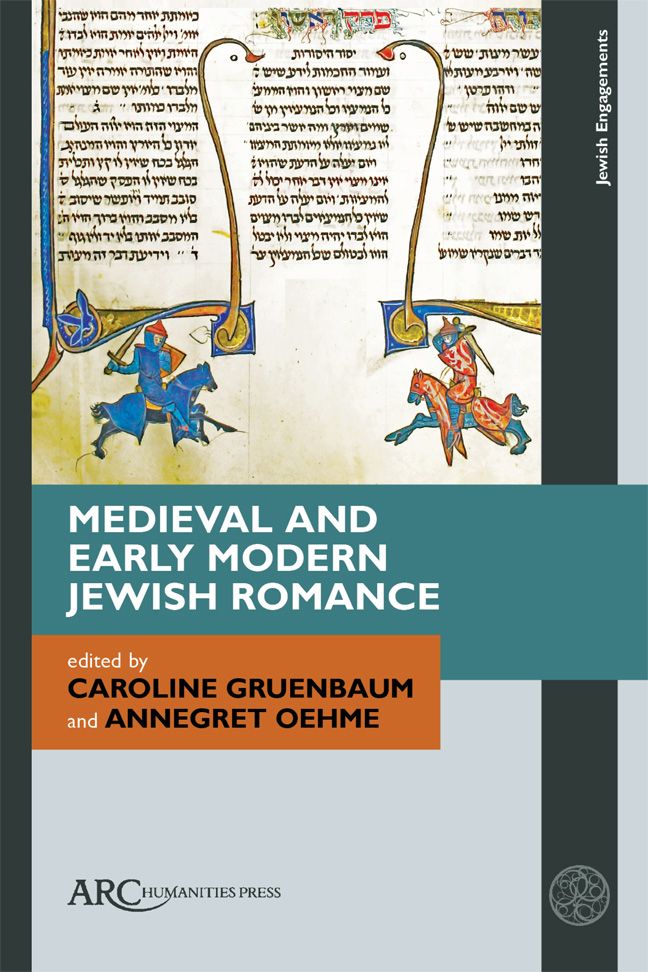Book contents
- Frontmatter
- Dedication
- Contents
- List of Illustrations
- Acknowledgements
- Introduction
- The Zohar as Medieval Jewish Romance
- Letters of Loathing: Immanuel of Rome and Romance Epistolary
- Illuminated Knights and Tales of Romance in the Rothschild Miscellany
- The Queen Nudatio: A Romanesque (?) Topos in Israel Caslari's Roman d’Esther
- At the Court of the Demon King: The Story of the Jerusalemite and Chivalric Romance
- Melekh Artus as a Jewish Romance: Horizons of Expectation and Genre Configurations
- A Friend in Need is a Friend Indeed?Friendship, Love, and Loyalty in the Yiddish Seven Sages of Rome
- Stealing Back One's Husband: The Yiddish Mayse mi-Danzek in the Context of Early Modern German Cross-Dressing Narratives
- Romance Elements in Meshal Haqadmoni by Isaac Ibn Sahula: A New Reading
- Afterword: Jewish Romance in Search of Identity
- Select Bibliography
- Index
Romance Elements in Meshal Haqadmoni by Isaac Ibn Sahula: A New Reading
Published online by Cambridge University Press: 18 February 2024
- Frontmatter
- Dedication
- Contents
- List of Illustrations
- Acknowledgements
- Introduction
- The Zohar as Medieval Jewish Romance
- Letters of Loathing: Immanuel of Rome and Romance Epistolary
- Illuminated Knights and Tales of Romance in the Rothschild Miscellany
- The Queen Nudatio: A Romanesque (?) Topos in Israel Caslari's Roman d’Esther
- At the Court of the Demon King: The Story of the Jerusalemite and Chivalric Romance
- Melekh Artus as a Jewish Romance: Horizons of Expectation and Genre Configurations
- A Friend in Need is a Friend Indeed?Friendship, Love, and Loyalty in the Yiddish Seven Sages of Rome
- Stealing Back One's Husband: The Yiddish Mayse mi-Danzek in the Context of Early Modern German Cross-Dressing Narratives
- Romance Elements in Meshal Haqadmoni by Isaac Ibn Sahula: A New Reading
- Afterword: Jewish Romance in Search of Identity
- Select Bibliography
- Index
Summary
THE HEBREW GENRE of the maqama, based on the foundations of the Arabic maqama—usually defined as a text written in rhymed prose, interlaced with short poems, with a plot, two characters (protagonist and narrator), and recurring motifs—evolved as a separate literary form from the end of the twelfth century and throughout the following century. The fact that this Arabic genre found its way into the Hebrew literature of Christian Spain reflected its susceptibility to Christian-European literary influences, specifically genres written in the Romance languages. This too influenced the specific and unique traits of the Hebrew maqama. In this chapter I suggest a new reading of Meshal haQadmoni by Isaac Ibn Sahula, written in Hebrew in Castille in 1281. Focusing on some of its romance generic elements, I examine some of the key elements of the genre that are found in this work, focusing specifically on its form as a frame story, which may be read as a romance by its genre alone. Thus, I will begin by attempting to provide a concise definition of romance literature and the Spanish maqama.
The literary genre known as the maqama (plural: maqamat) reached the height of its popularity in Christian Spain in the twelfth and thirteenth centuries. Unlike the poetry of the Golden Age, which had strict rules dictating its structure and content, these narrative works written in Christian Spain were innovative in both aspects. From a literary point of view, this era was unique as it heralded a new literary genre: stories written in rhymed prose, interlaced with poetry. While some writers adhered to the classic structure of the Arabic maqama, many chose to use other popular forms of writing or even developed new ones, sometimes focusing upon subjects that had not been addressed in writing to date. The evolution of the maqama's classic pattern led to the refinement of new design methods and story techniques, as well as a great variety of new topics. Thus, the Spanish maqama was created, presenting as a sub-genre of the classic Arabic maqama. Dan Pagis, who examined the distinctions between the classic (Arabic) maqama and the Spanish one, found that determining the specific type of maqama was often problematic, as the works written from the mid-twelfth century to the early fifteenth century were highly diverse.
- Type
- Chapter
- Information
- Medieval and Early Modern Jewish Romance , pp. 171 - 196Publisher: Amsterdam University PressPrint publication year: 2023

